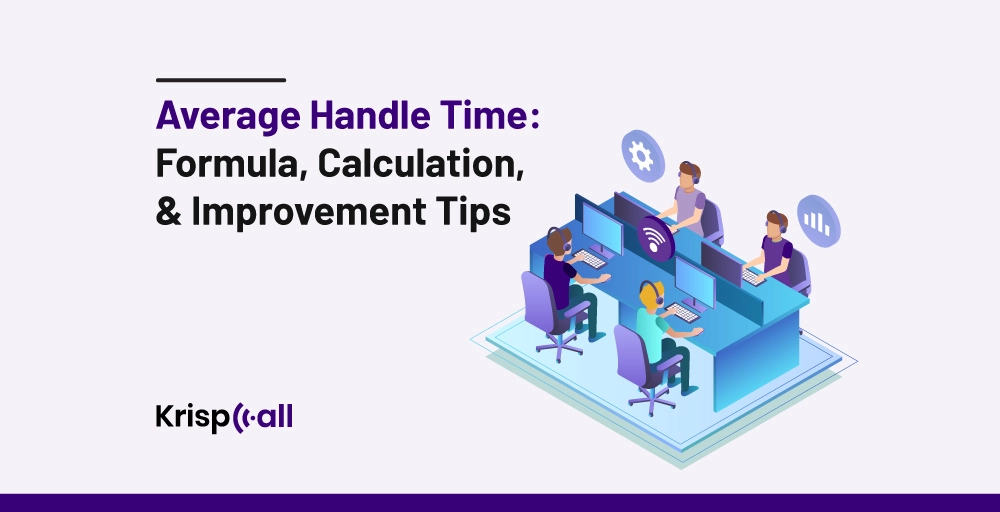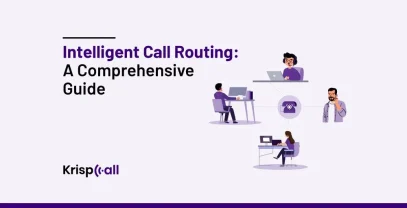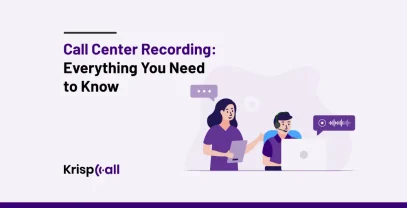You might have felt the pressure 😒 to balance efficiency with exceptional customer service in your call center.
However, now average handle time, a key metric, dives into the heart 😀 of call center operations, providing insight into the average time it takes agents to resolve customer inquiries. In addition, it helps you identify areas for improvement, ultimately leading to streamlined call handling and boosting agent productivity.
👉In this article, we’ll gain an understanding of average handle time, the formula to calculate AHT, and some tips to improve your AHT.
So, let’s dive in.
🔑 KEY HIGHLIGHTS
- Average Handle Time refers to the average time it takes agents to resolve customer queries.
- The most efficient method for calculating call AHT is to divide the total handle time by the total number of calls.
- Generally, a handling time of around six minutes is considered optimal across various industries.
- Specialized agent training, recording calls, monitoring agents’ performance, and investing in employee experience are ways to improve Average handle time.
- An excellent average handle time aims for the shortest duration, effectively resolving calls and boosting customer satisfaction without rushing the process.
What is Average Handle Time (AHT)?
Average handle time is the amount of time it takes to help a customer in a call center. It is one of the KPIs (Key performance indicators) that is tracked to evaluate the efficiency of customer service agents and overall call center performance.
The average handle time includes the entire customer interaction, from when the call begins to hold time to until the call hang-up. A good AHT is one that efficiently balances between speed and quality of customer call service.
Average handle time helps you see how your agents are performing in resolving customer queries.
📙Read: What is Average Handling Time & How to Reduce it in a Call Center?
Why Is Average Handle Time Important?
Average Handle Time (AHT) is an essential metric in the call center industry, impacting customer satisfaction, cost, and company efficiency. Solving a customer issue within a time frame provides customers with a good insight into the company’s image and builds a relationship with the organization.
Here are some of the reasons why average handle time is important 👇:
- Agent productivity: AHT allows supervisors to monitor their agents to see how efficiently they handle customers’ issues. This helps organizations to identify problems and make required improvements to boost agents’ overall effectiveness and productivity.
- Customer Experience: Every customer wants a quick response and solutions to their issue. Taking long time to resolve the problem can provide a negative experience to customer. Therefore, having low AHT typically means an increase in customer satisfaction.
- Identify internal bottlenecks. Average handle time provides a insight into agent and overall call center performance. This helps you to identify the areas for improvement in your contact center.
- Cost reduction: One of the main reasons why AHT is important is due to its cost reduction. You can easily optimize inefficiencies and wasted time. This helps you to save costs by reducing overheads like labor requirements and overtime payments.
How to Calculate Average Handle Time?
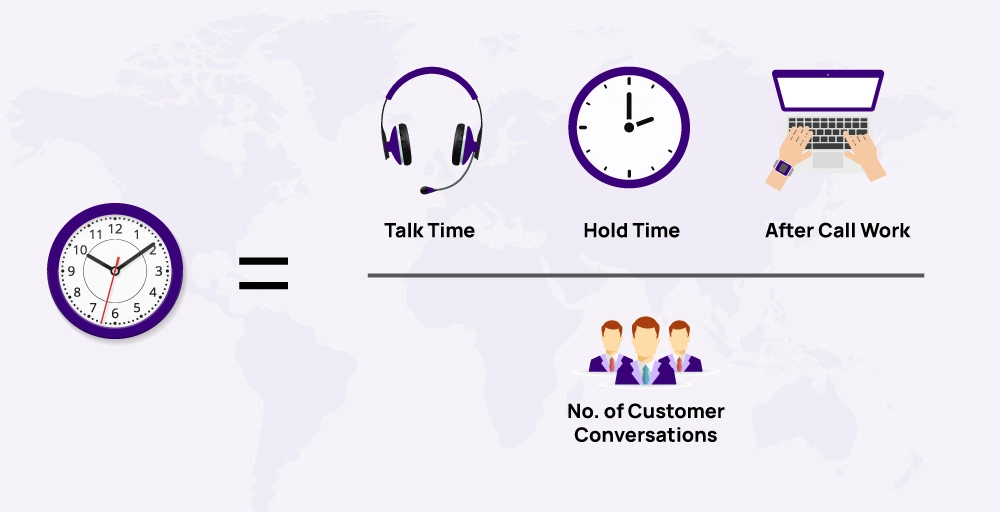
The most efficient way to calculate call AHT is to divide the total handle time by the total number of calls. Here is the formula:
AHT = (Talk Time + total hold time + follow-up time) / Total Number of Calls
This formula includes the time spent in the conversation (total talk time), the time spent while the call is on hold (Total hold time), and the time spent on follow-up activity(Total after-call work Time). It then divides these times by the number of calls the agent handles to get the average handle time.
AHT Calculation example
Let’s say you made 70 calls in a day and had a total talk time of 1960 minutes, a total hold time of 250 minutes, and a total follow-up time to add the notes in the CRM of 170 minutes. So, the equation will be
AHT= (1960 + 250+170) / 70 = 34 minutes
Your average handle time is 34 minutes.
The unit of measurement must be the same for the formula to work. If you enter minutes in the total time, you should also enter other aspects with the same measurement unit, but you can only choose one per calculation.
What Is a Good Average Handle Time?
Good average Handle time depends on various factors, including the complexity of customer inquiries, the nature of the business, and industry standards. However, typically, six minutes is considered the best handling time across various industries.
An excellent average handle time (AHT) efficiently balances the speed and quality of customer call service. It can vary from industry to industry but aims for the shortest duration that resolves calls effectively, boosting customer satisfaction without rushing the process.
📙Also read: How To Handle Unexpected Call Volume Spikes?
What Causes High Average Handle Time?
High Average Handle Time (AHT) in customer service or call center environments can stem from various interconnected factors, each contributing to the overall length of customer interactions.
One significant contributor to elevated AHT is the complexity of customer inquiries. When customers present complex issues or technical problems, agents may require additional time to understand the situation thoroughly and provide a suitable resolution.
These complexities can range from intricate product queries to troubleshooting technical difficulties, demanding a more thorough investigation and resolution process.
Factors Affecting Average Handle Time
Balancing AHT with customer expectations is really important. Various factors can affect the Average Handle time. Some of the key factors are listed below 👇:
- Lack of agent knowledge: If the agent lacks knowledge about the company’s services and products, it might consume more time as they need to search for the information. It will create delays and frustration for agents, leading to high AHT.
Sometimes, agents with limited knowledge may provide wrong information about the company product. This can create customer frustration and require further calls to rectify the situation. This process will significantly increase AHT.
- Technical problems: While using technology, you cannot ensure whether it operates properly. It may create issues while resolving the customer.
For example, imagine your agent needs to gather information about the customer, but the system is currently down. Unwanted updates, forced troubleshoots, and slow loading times can make Agnet stressed and less productive.
Sometimes, when the agent fills in the information about customer inquiries, technical issues might cause dropped calls. So, the customer will need to call again, creating dissatisfaction and further inflating AHT.
- Ineffective automation: Ineffective chatbots and self-service portals provide better assistance for agents, which guides them through easy issues and allows them to focus on complex topics. But this may backfire if the agent became more dependent and has started to take help with every customer inquiry.
Chatbots are designed to answer by focusing on the input keyword. If agents can’t input the solution they seek, they may get stuck in loops, eventually leading to more AHT.
How to Improve Average Handle Time?
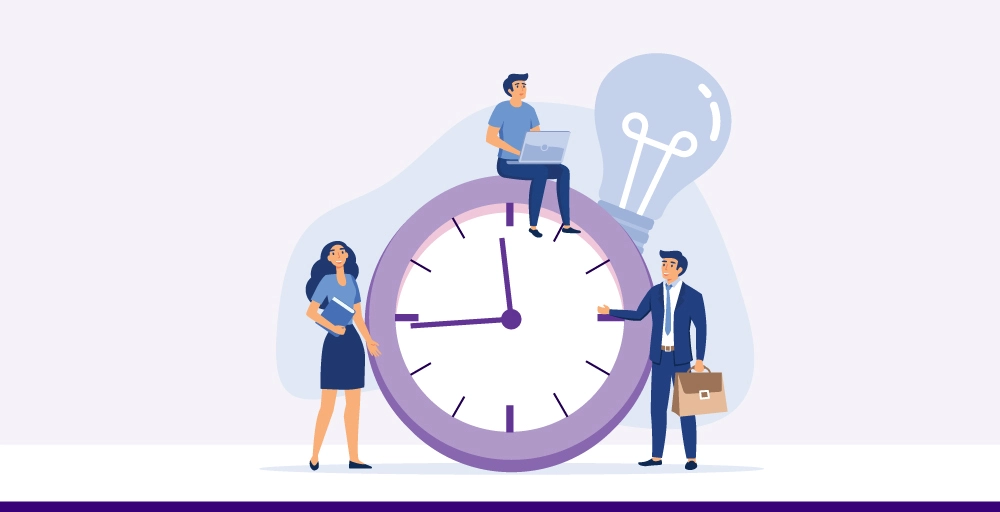
Let’s discuss some of the important tips to improve Average Handle time 👇:
- Offer specialized agent training: This method can significantly improve the average handle time. Specialized agent training lets your agent adapt around specific inbound queries or customer segments. Provide your agent with a document of all your products and services in an internal knowledge base, and keep in sight how many employees specialize in each.
- Record calls and monitor agents’ performance: Call recordings allow supervisors to track agents’ performance. By analyzing the recordings, you can find areas where agents are struggling to resolve customer inquiries effectively. Then, guides and training will be provided for agents to improve their performance.
Call recordings can also be a great resource for recognizing best practices among top-performing agents. By finding out how the top agents handle the calls, they can create strategies and new approaches to resolve customer issues effectively and in a less time-consuming way. This method can help reduce average handle time effectively.
- Investing in employee experience: When call center agents feel valued, engaged, and well-equipped, it directly translates to a more positive customer experience. This translates into smoother interactions, reduced frustration for both parties and ultimately, lower Average Handle Time.
By prioritizing employee experience, you create a win-win situation for both your agents and your customers.
- Assign high AHT agents a low AHT agents: Every agent may not be perfect in this AHT thing. Some may have a low AHT, while some may be low-performing agents. So, identify and pair the low AHT agent with a high AHT agent. This way, the low AHT agent can provide proper guidance and feedback to the high AHT agent to eliminate unnecessary delays.
Learning from a more experienced individual will provide a better understanding of the job. They can also share available shortcuts to speed up the call process.
- Encourage Empowerment: Encouraging agents motivates them to handle customers and make decisions without waiting for their supervisor’s approval. This helps to resolve the issue more quickly, resulting in low handling time.
When the agent is empowered to make the decision, there are fewer call transfers as they try to handle the inquiries themselves. This automatically leads to low AHT as the time spent transferring calls is deducted.
📙You may also like: Call Center Management: Strategies, Tips, and Best Practices
Final Thoughts
Average Handle time has now become a metric that companies use to evaluate their agent performance and also a way to make further enhancements in their customer support department. It allows companies to develop further strategies properly in the required areas. Low AHT is important because solving a customer issue within a time frame provides customers with a good insight into the company’s image and builds a relationship between customers and the organization.
An excellent average handle time aims for the shortest duration, effectively resolving calls and boosting customer satisfaction without rushing the process.
FAQ
What is AHT and its formula?
AHT or Average handle time is simply the average of the time taken between customer and agent. This includes a call on hold, total talk time, and total time for follow-up divided by the total number of calls handled. The formula to calculate AHT is:
AHT = (Talk Time + Total hold time + Total after-call work Time) / Total Number of Calls
How do you calculate average hold time?
To determine the average hold time, sum up the total duration of all calls and then divide by the total number of calls handled.
What is the average handle time analysis?
The average handle time is to examine call data to understand how long it takes to resolve customer inquiries in a contact center.
What is the average handle time benchmark?
The average average handle time depends on various factors, such as the nature of the business, the complexity of customer inquiries, and business standards. According to statistics, a favorable Average Handle Time (AHT) typically falls around 6 minutes.
How do you maintain average handle time?
To maintain average handle time, providing specialized agent training, recording calls, monitoring agents’ performance, and investing in employee experience are ways to improve Average handle time.

